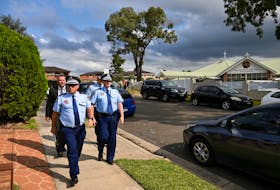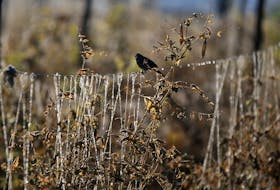Second World War battles still rage intermittently in the uncluttered mind of 98-year-old veteran Havelyn Chiasson.
“I wake up at night dreaming about it, I still do,” said Chiasson, alertly recounting from the comfort of his Portland Hills condo in Dartmouth the D-Day invasion and other wartime events from a lifetime ago.
“You wake up and you are in with a group of people and they say, ‘Here comes Have but he looks so old.’ They are all young people. You see them as young, you see them as they were then.
“I’ve had that happen several times.”
Some of the young faces he sees in his dreams never had the opportunity to age.
“No, no, no,” Chiasson said sadly about the casualties of war.
“We often say, those of us who have been there, the worst shock was that you and I have been together for five years, the whole battalion. We were just like brothers. And, all of a sudden, here was somebody dropped next to you and he was wounded quite badly and you would like to help him out but you couldn’t, you had to go on. Somebody else had to do that. If you were laying there next to him for a little bit, you might put a bandage or something on him but that’s all could do.”
The hardest part was leaving the dead and wounded behind, Chiasson said.
“You had to go on. That wasn’t your job.”
Born in Miscou Island into a fishing family in northeastern New Brunswick, Chiasson learned early about duty and the job that had to be done.
He enlisted with the North Shore regiment in Bathurst in 1940 not long past his school days.
“That was the thing to do, and we were getting $1.25 a day and that was a lot of money. A lot of our parents weren’t making that kind of money.”
Chiasson trained in Bathurst and then moved on to the new camp in Sussex, N.B., the town where he would make his home after earning Second World War honours as a corporal and a radio operator.
Chiasson said there were about 5,000 enlisted men training in Sussex before they departed for England in June 1941.
First combat was D-Day invasion

Chiasson was among some 1,000 soldiers stationed in hotels near Boscombe in the south of England. For months on end, they would train day and night at Portsmouth and Southampton, moving from ships to landing craft and back to the ships.
Chiasson said that at one o'clock one morning the bugle sounded and the men were told to be down in their transport trucks in 15 minutes with all their equipment. He said he tells that story during his many visits to schools and the students ask how the troops could be ready so quickly.
“We done it 100 times before. All your equipment was ready every night.”
After staying in the woods near the English coast overnight, they boarded the ships for their first active combat — the D-Day invasion of Normandy or what his superiors were calling the Second Front.
After a day lost to bad weather, the ship landed off Saint Aubin-sur-Mer in Normandy on the morning of June 6, 1944.
“On our left flank the British and way up on our right flank the Americans,” Chiasson said. “We all were supposed to hit the beaches at the same time. …We got down into our landing craft. The Germans opened up with everything they had. Planes were coming in there from England, bombing the beaches and all the destroyers and cruisers were shooting at the beaches. There were 35 men to a (landing) craft and a lot of them were shot with bombs. Then you’d hit mines. Mines would blow a whole landing craft.”
Despite all the training that preceded the D-Day assault, the Allied troops weren’t really prepared for what awaited them on the Normandy beaches.
“No training will stop a bullet, you know,” Chiasson said.
The landing craft battled bad weather to get troops close enough to the beaches.
“It could have been better and it could have been worse. If the weather had been good, we’d have more casualties. With the weather being bad, we had enough, but we had probably less. You never know.
“The North Shore lost 100 men the first day, the first hours. We captured our beach.”
Chiasson said the Americans had a “real hard time,” because of hills and cliffs on the beach they were targeted to storm.
“Ours was a flat beach with a stone wall. Some of us got behind that stone wall and that saved our lives because they were just machine-gunning the beach. We captured a mile of beach, a mile long and a half mile wide the first night. That’s where we spent the night. The Germans strafed and bombed us all night long, along with the shelling. And then things started from there.”
A long push through Europe
The start had the North Shores pushing inland.
“They thought we were going to reach Caen in the middle of the afternoon. We were 33 days before we got to Caen. We captured the airport at Capriquet. A lot of us got medals for that.”
Chiasson and his North Shore battalion fought all the way through France and Belgium and into Holland. They were fighting just inside Germany when the 1945 ceasefire finally ended the hostilities.
“I never was wounded. I was hit twice, once in the hand and once in the head. Just bits of shrapnel, nothing to be evacuated for.”
Chiasson lives alone in Dartmouth but his daughter and only child, Carolyn, lives nearby. He has been back to France and Holland 10 times, primarily for wartime anniversaries and has been awarded several honours, including the prestigious Legion Medal of Honour in France. On his return trips, Chiasson would often visit the Groesbeek Canadian War Cemetery in Holland and the Beny-sur-Mer Canadian War Cemetery near Juno Beach in Normandy. He marvels at how the young people maintain the cemeteries and gravesites and how the French and Dutch would line the streets for remembrance parades.
“A young girl was telling me that in Holland, you weren’t allowed on the streets after six o’clock, nobody,” he said of the German occupation. “Her brother was 16 and he said to his dad ‘I’m going across the street to visit my friend in that apartment.’ His father said ‘Don’t go out that door, don’t go.’ But he was looking down the street and there were no Germans on the street, no guards. So he went out the door and made about four steps and a vehicle came along and shot him. They (family) couldn’t go out and pick him up. He had to stay there all night. He was dead.
“That’s why they are so appreciative. Our (Canadian) people heard about what we did but they never seen it.”
D-DAY AT 75: Remembering the heroes and sacrifices of Atlantic Canada:
- VIDEO: The road to D-Day
- Why a school in France is named for a Pictou soldier
- U-boat hunter Roderick Deon returns to Juno Beach for D-Day
- Sound of gunfire rang in P.E.I. soldier’s ears
- North Nova Scotia Highlanders at the sharp end of D-Day invasion
- STORY MAP: Follow the D-Day experience of the North Nova Scotia Highlanders
- 12 North Nova Scotia Highlanders murdered at Abbaye d’Ardenne
- ‘It was noisy as the devil,’ says St. John’s torpedo man
- 59th Newfoundland Heavy Regiment was eager to do its part
- A P.E.I. dispatcher’s long, uncertain journey to Normandy
- LAURENT LE PIERRÈS: D-Day invasion was best birthday present for my Dad
- ‘Sight of our boys being blown up ... wouldn’t leave my mind:’ Bedford veteran, author
- Dartmouth veteran's first combat mission was D-Day invasion
- Halifax air gunner had bird’s-eye view of D-Day
- ‘We had everything fired at us but the galley sink’: Yarmouth County veterans share war and D-Day memories
- New Waterford veteran has lived good life after surviving D-Day invasion
- JOHN DeMONT: An old film clip of D-Day shows the nature of courage
- D-Day landing map’s origins a mystery to army museum historians








